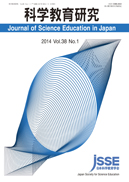All issues

Volume 21, Issue 3
Displaying 1-5 of 5 articles from this issue
- |<
- <
- 1
- >
- >|
-
Genzo NAKAYAMAArticle type: Educational Issue
1997 Volume 21 Issue 3 Pages 135-144
Published: September 10, 1997
Released on J-STAGE: June 30, 2017
JOURNAL FREE ACCESSOn the brink of the 21st century, more debate exists now than ever before about school education that places particular emphasis on the development of skills needed to cope with social changes in Japan. It is an urgent need to begin considering restructuring the school curriculum, including reorganizing and integrating the existing subjects. With regard to education relevant to the advancement of science and technology, children's interest in science should be increased through the provision of more practical experience and through encouraging children to develop their own ideas, so that they should be able of better scientific perception and thinking. Environmental education should be improved and enriched with a view to foster children's awareness of the environment and nature, and cultivat the ability to act spontaneously to conserve the environment, and create a better environment. Information education should also be carried out with a view to cultivating in children information literacy relevant to the age of advanced information technologies. Each school should set up "school periods for synthetic learning", covering such themes as nature experiences, environmental protection, and information media.View full abstractDownload PDF (825K) -
Olugbemiro JEGEDEArticle type: Research Article
1997 Volume 21 Issue 3 Pages 145-153
Published: September 10, 1997
Released on J-STAGE: June 30, 2017
JOURNAL FREE ACCESSThe literature shows that the cultural background and the worldview presupposition of a learner can have a great influence on achievement in education. When students base their reasoning on a non-Western worldview, they tend to be inhibited from constructing concepts. This further alienates learners, from indigenous or minority groups who must fit within the world of the majority, whose success at learning must be measured from a Western framework. This paper discusses the cultural borders learners from a non-Western/indigenous background have to cross daily to acquire education within a modern day context. It also discusses the theory of collateral learning, a progression that appears to move from anthropological instruction to autonomous acculturation, to explain the coping mechanism which goes on in the schema of the non-Western learner in order to cross borders from a hazardous (symbolically violent) to a secured learning environment.View full abstractDownload PDF (803K) -
Colin WOOD-ROBIMSON, Jenny LEWIS, John LEACH, Rosalind DRIVERArticle type: Research Article
1997 Volume 21 Issue 3 Pages 154-171
Published: September 10, 1997
Released on J-STAGE: June 30, 2017
JOURNAL FREE ACCESSThis paper discusses the place of genetics in the context of scientific literacy and the school science curriculum. It then goes on to report on the work of an on-going three year research project which seeks to document the understanding of genetics, and of modern genetic technologies, and opinions on these technologies among 15-16 years olds in England. Two aspects of the work concerned with understanding the genetics of cells and with opinions on the advisability of prenatal screening for cystic fibrosis are presented. The implications for the school curriculum and for teaching are then discussed. The authors are grateful to the Wellcome Trust for their support in enabling this research.View full abstractDownload PDF (1502K) -
Kouhei HARADA, Nobuhiko NOHDA, Elisabeth GALLOU-DUMIELArticle type: Research Article
1997 Volume 21 Issue 3 Pages 172-182
Published: September 10, 1997
Released on J-STAGE: June 30, 2017
JOURNAL FREE ACCESSThis paper is a research report of France-Japan Collaborative Research about the Role of Conjectures in Problem Solving in Geometry. The purpose of this research is to clarify the effects of using the computer software Cabri-Geometry as a means of helping students who had difficulties in geometrical proof-problem solving. For this purpose, we made four didactical experiments in France and Japan. The subjects were the 9th grade students in France and 8th grade students in Japan. In conclusion, we clarified effects of using Cabri-Geometry as follows : (1) In both France and Japan, by using Cabri-Geometry in geometrical proof-problem solving, the students could gain "dynamic viewpoints of figures" and then could discover valid "procedures for proof' to solve the problems. (2) In France, the students could gain "visualization for geometrical figures" based on "dynamic viewpoints of figures" by using Cabri-Geometry. (3) In Japan, the students could gain a more impressivd "dynamic viewpoints of figures" by using Cabri-Geometry and could gain "changing viewpoints of figures" based on "dynamic viewpoints of figures".View full abstractDownload PDF (758K) -
Hae Kyung KIM, Emiko MASUJIMA, Haruhiko TANAKA, Hiroshi OCHIAIArticle type: Research Article
1997 Volume 21 Issue 3 Pages 183-195
Published: September 10, 1997
Released on J-STAGE: June 30, 2017
JOURNAL FREE ACCESSThe treatment of environmental problems in secondary school chemistry in Korea and Japan was analyzed on the basis of the environmental content in science/chemistry textbooks. The analysis revealed that environmental problems were practically not included in chemistry textbooks until various types of pollution became serious in both countries. Many efforts to promote Environmental Education (EE) in the field of chemistry have been made but have focused mainly on environmental knowledge and did not deal with the practical aspects of solving environmental problems. It seems necessary to use other teaching materials in chemistry classes to lead students to logically understand the environment and to deepen their awareness of the importance of its protection. Significance of further development in EE and educational recommendations are also discussed.View full abstractDownload PDF (1142K)
- |<
- <
- 1
- >
- >|